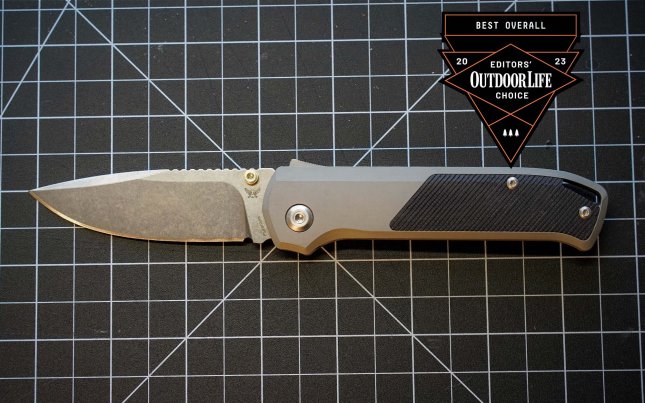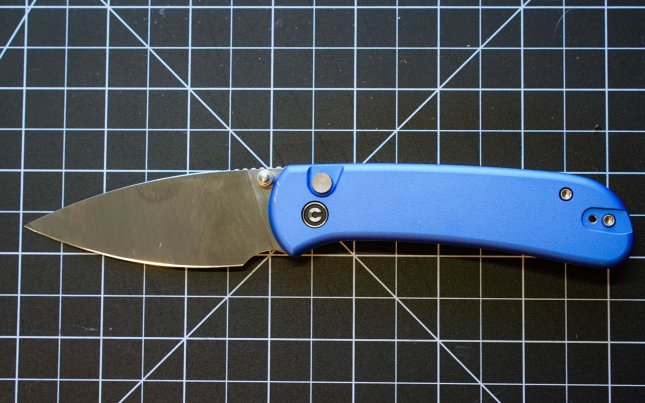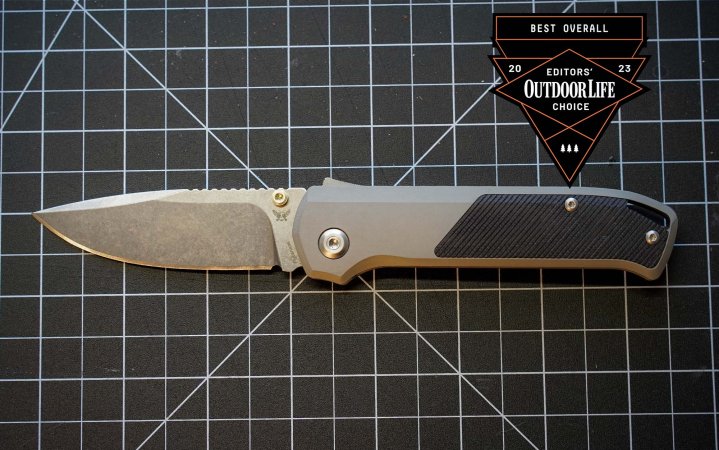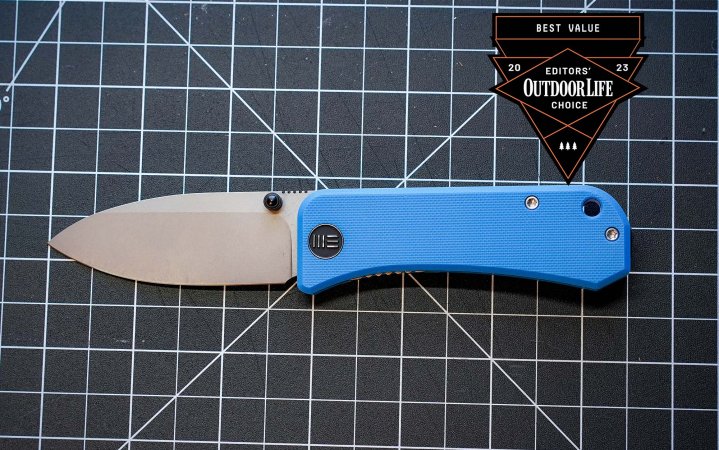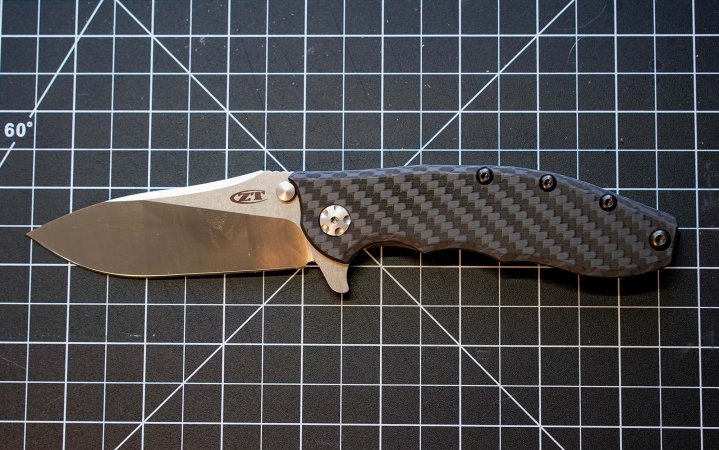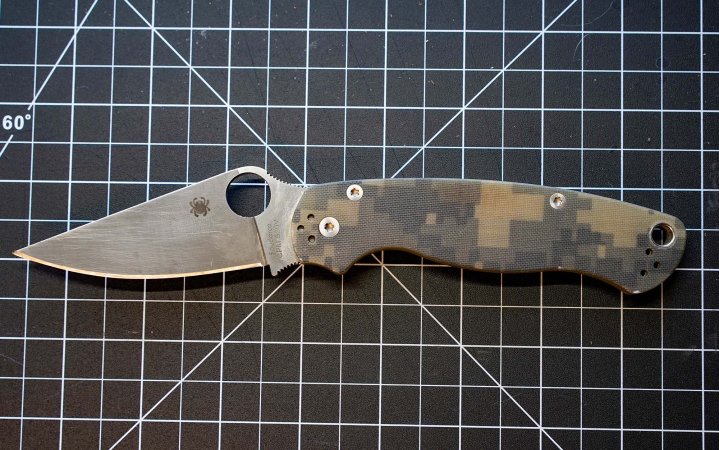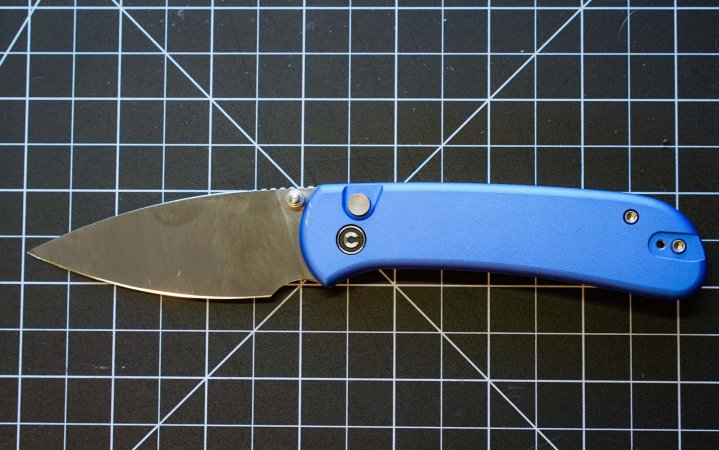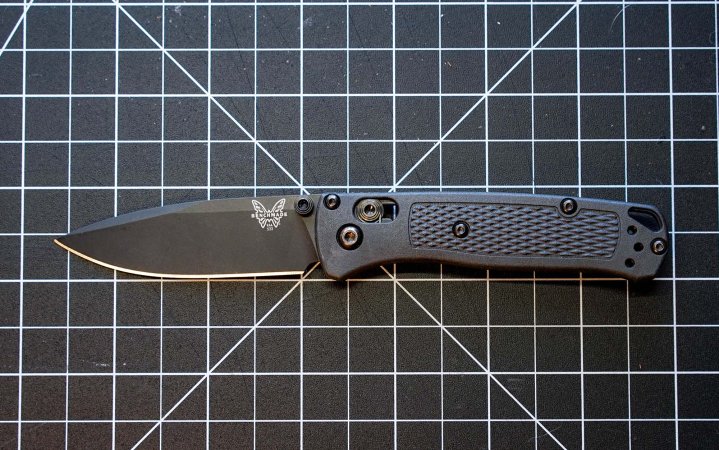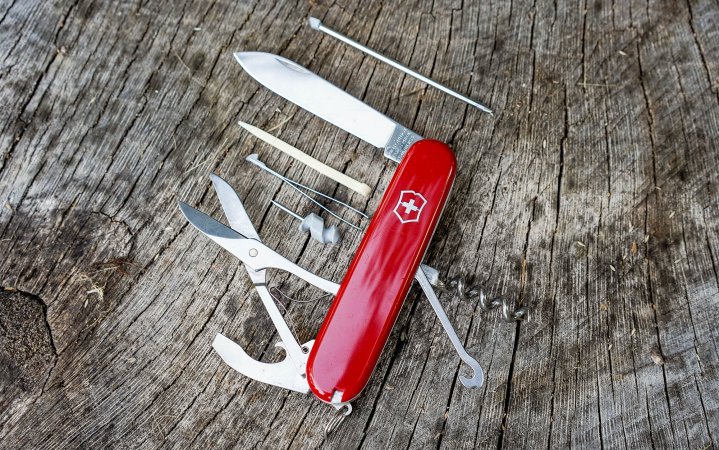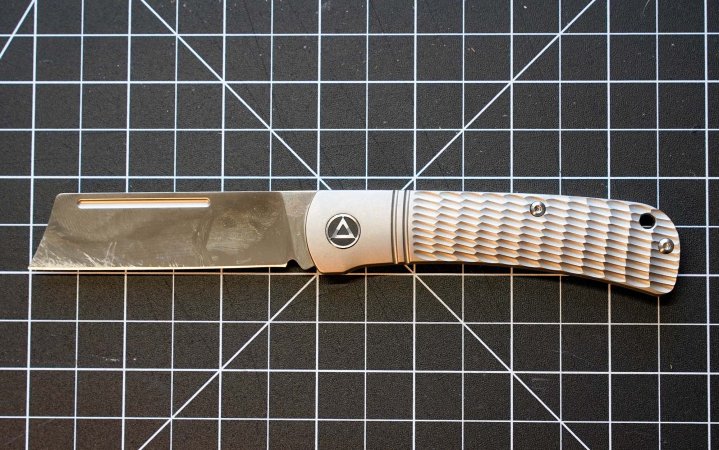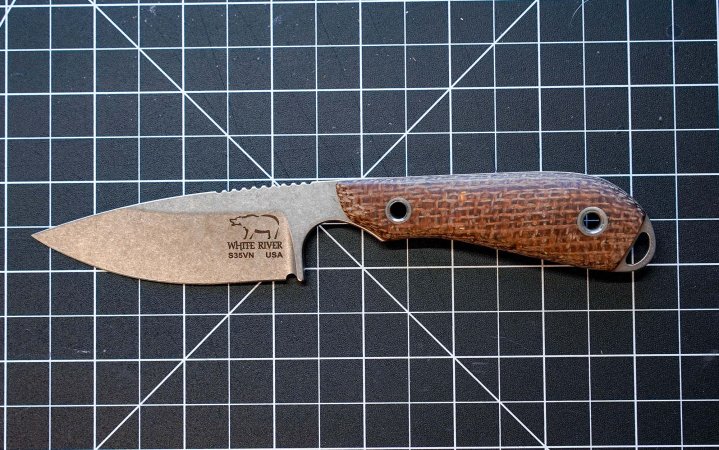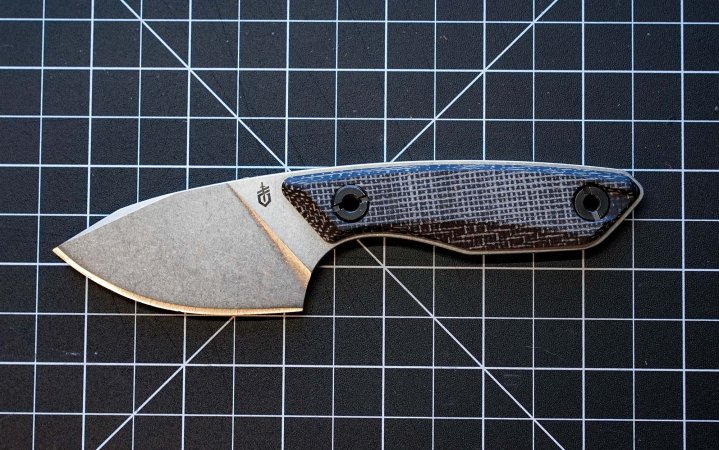We may earn revenue from the products available on this page and participate in affiliate programs. Learn More ›
I cut over 380 feet of cardboard in addition to 1, 292 cuts through oak dowels, apples, wire ties, rope, paracord, utility cuts, and water bottles while testing 38 EDC knives. And I have just enough strength left in my hands to type up the results.
After all that work the outcome was still too close because there are so many great knives. So I lined up the top performers and resumed cutting until I had a definitive best overall, a best value, and nine other knives that beat out the tight competition.
Here are my final best EDC knife picks.
- Best Overall: Flytanium Arcade
- Best Value: WE Banter
- Best Hard Use: Zero Tolerance 0562CF
- Best Slicer: Spyderco PM2
- Best Replaceable Blade: Exceed Designs TiRant Razor V3
- Best for $60: Civivi Qubit
- Best Ultralight: Benchmade Mini Bugout
- Best Multi-Tool: Swiss Army Compact
- Best Modern Slipjoint: QSP Hedgehog
- Best Fixed Blade: White River M1 Caper
- Best Budget Fixed Blade: Gerber Stowe
Scroll past the reviews for sections on traditional pocket knives, high-end folders, and honorable mentions.
How I Tested the Best EDC Knives

I’ve collected knives for 10 years and I’ve been able to own some great production knives including my two favorites—the OZ Machine Co. Roosevelt and Brown Knives Mini FDS-I. I also use all the knives in my collection, so while I have deep appreciation for quality machining and a finely-tuned detent, my first priority is always cutting.
My idea of the ultimate EDC knife is one that can tackle any cutting task short of batoning firewood. I need a knife that can make powerful cuts as easily as it makes detailed ones. So I designed my test to find knives that could cut a wide variety of materials and excel at different types of cuts. Once the dust settled on the top performers I took into consideration things like build quality, ease of carry, fidget factor, and value.
The Cut Test
Phase One
The cut test simulated common use cases and tested how the EDC knives performed when gripped in different ways. I ran each knife through a gauntlet, which was timed as a metric for how easily the knives performed the tasks.
The cut course included:
- 10 feet of cardboard
- 10 zip ties
- Water bottle (cut around the circumference to simulate clamshell packaging)
- 10 rope cuts (8mm jute)
- 10 Paracord cuts
- Utility cut (a circle traced on cardboard)
- Cut through a 0.5-inch, oak dowel
- Apple
- Paper cut to test edge retention
After the cut test each knife was given a score from 1 (poor) to 5 (perfect) on the following characteristics:
- Ergonomics
- Action
- Build quality
- Slicing
- Precision cuts
- Power cuts
- Ease of carry
- Value
- I deducted 10 points for knives that took damage during the test. Knives that retained the same edge quality after the test got five bonus points.
Phase Two
The initial test helped me narrow the field from 38 to 15 knives. I divided the knives according to those in running for best overall and best value. Then I compared their performance through cardboard, rope, and wood. The direct comparison helped me find the knife that was the most well-rounded cutter and had all the features of a great EDC knife.
But what about…
Please don’t be sad if your favorite knife wasn’t tested or, even worse, didn’t make the final cut. I’m sure it’s still a great knife and will serve you well. When choosing knives for the test I wanted an assortment of knives under $300, that are readily available (not limited runs), and tried to include as many U.S.-produced options as possible. There are hundreds of pocket knives that meet those criteria, but my budget and time does not allow me to test them all.
I’m certain that the knives that made my final cut are among the best available. When it comes time to do this test again in August 2024, they’ll all be ready to do battle against the next crop of challengers.
Best EDC Knives: Reviews & Recommendations
Best Overall: Flytanium Arcade
Pros
- Excellent locking mechanism
- Great action
- Top cutting performance
- Customizable (50,000+ configurations)
- Easy to carry
- Ideal blade length-to-weight ratio
- Lefty friendly
Cons
- Not the most exciting blade steel
- Some will prefer G10 slabs or full titanium over the aluminum handles
Key Features
- Blade Length: 3.2 inches
- Overall Length: 7.7 inches
- Weight: 3.2 ounces
- Blade Steel: S35VN
- Deployment Methods: Thumb stud or Shark-Lock tab
- Demko Shark-Lock
- 6061 aluminum scales with G10 or Micarata insert
- Uses ceramic pivot bearings
- Made in Taiwan
- Price: $199

The Arcade was among the elite cutters in my test and it has one of the strongest lock designs ever made— Andrew Demko’s Shark-Lock. Those features combined with its scant weight, deep carry clip, and fun action propelled it to the Editor’s Choice win.
Flytanium’s Arcade turned in the fastest cut course time by being good at all the cutting tasks rather than exceptional at one. While cutting cardboard head-to-head it held its own against the PM2, but the slicing edge went to the Spyderco. The Arcade excelled at the dowel cut, biting deep into the wood, and the comfortable ergos allowed me to put a lot of force behind the cuts. The blade has a nice straight section for cutting rope and a strong tip for piercing cuts.
I personally think that S35VN is one of the best EDC steels, but I get that it’s not the newest and most exciting option available. I’d guess that as this knife gains in popularity we’ll see it offered in Magnacut or one of the other in-demand steels. More important than the chosen material is that the factory making Arcade has a good heat treat on their S35VN because it didn’t chip or lose sharpness throughout testing.

The ergos are deceptively simple on the Arcade, but they’re well executed. You can choke up for detail cuts and make powerful cuts with the use of the aggressive jimping. In the oak dowel phase there was only slight discomfort around the grip’s edges, but nothing so harsh that I’d call it a hot spot.
The Arcade I used for the test is my personal knife, so it’s seen a lot of pocket time. I’ve found it to be one of the nicest full-sized knives for EDC. It sits deep in the pocket and I barely notice it. One area it could be improved is a little more clip tension for more security with thinner pants materials.
I’ve also tested Flytanium’s customer service. When I got my knife, it would click when pressure was applied to the spine. I emailed Flytanium who promptly sent me a shipping label and returned my knife back to me within a week in perfect working order. The customer service person I emailed with was kind and helpful throughout the whole process.
Update: After nearly a year, I’m still carrying the Flytanium Arcade as an EDC and it’s still excellent. The edge hasn’t taken any damage, the action is still smooth, and I’ve been impressed by its edge retention.
Also Consider: Where’s the Demko AD20.5? I own an AD20.5 and carry it often. I tested it and it was one of the knives that did great, but ultimately came up just short of making the final cut. If you want a knife that has the Shark-Lock, but is more hard-use oriented than the Arcade, the AD20.5 is a fantastic option. I’d also take a look at Demko’s new slicer grind options and smaller Shark Cub.
Best Value: WE Banter
Pros
- Great action
- Really good ergonomics, especially for its size
- Top cutting performance
- Easy to carry
- Great value for the money
- Lefty friendly
Cons
- Lockbar access could be improved
Key Features
- Blade Length: 2.875 inches
- Overall Length: 6.5 inches
- Weight: 2.61 ounces
- Blade Steel: S35VN
- Deployment Method: Thumb stud
- G10 scales
- Linerlock
- Made in China
- Price: $128

The WE Banter was one of the most surprising successes of the entire test. The knife doesn’t look like much—a simple blade and handle design. But when I hit its thumb stud I was immediately impressed by its satisfying action. Then I was blown away at how it chewed through the oak dowel quickly, and it did so without inducing even the slightest hot spot. That performance shook up my expectations of what a small knife can do.
The action though, is really something special. It has that premium knife feel and an audible click as the blade locks open that is oh so sweet. You can easily pay three times the price of a Banter for the same experience. Like the Arcade, it wasn’t the top finisher at any one phase of the cut test, but very good at all of them. If you have a $100 budget, this is one of the best EDC knife options out there.
Also Consider: WE’s more affordable brand, Civivi, makes a Banter model that’s around $50. It’s the same design with budget materials.
Best Hard Use: Zero Tolerance 0562CF
Pros
- Slices well for a thick blade
- Excellent action
- Lefty friendly
Cons
- Some hot spots
Key Features
- Blade Length: 3.5 inches
- Overall Length: 8.3 inches
- Weight: 5.5 ounces
- Blade Steel: 20CV
- Deployment Method: Flipper
- Framelock
- Made in the USA
- Titanium and carbon fiber handle
- Price: $292

Hard-use knives are the jacked-up pickups of the knife world—they’re more about aesthetics than capability. But the ZT 0562 is different from the sharpened pry bars you’ll often find in this category because it can actually cut. It was designed by Rick Hinderer and incorporates many of Hinderer’s signature design elements like his Lock Bar Stabilizer and Slicer Grind. So you’re able to get a knife that’s similar to the highly sought after Hinderers at a cheaper price with more availability.
In the cut test, I could feel the thickness behind the edge while going through the cardboard and the edge geometry didn’t bite into the dowel. But, it still turned in a respectable cut course time against knives with thinner blade stocks. The main advantage to the thicker blade stock is that you have full confidence you won’t bend or break the blade while putting maximum effort into difficult materials. The 0562 also has a very useful drop point blade shape. While cutting the oak dowel there was a noticeable hotspot in the area where your pinky grips the handle.
The action is excellent by all metrics. The detent is well tuned, which helps shoot the massive blade open without fail. The steel lockbar insert clicks in place with a vault-like lockup. On closing it drops-shut with just a little encouragement and there’s not a hint of lockbar stick.
The 0562 is a quality, American-made workhorse that’s readily available at a reasonable price. It’s a great buy especially when you consider that to get a Hinderer you’ll pay $425 and have to wait for a batch of them to drop.
Also Consider: The new ZT 0545 came out after I started testing EDC knives. I’d recommend checking out that new model because it has a lot of the features I like about the 0562, but with Magnacut and a thinner blade grind.
Best Slicer: Spyderco Para Military 2
Pros
- Lots of sharpening life
- Good ergonomics
- Lefty friendly
Cons
- Hot spots created by the pocket when in the tip down position
- Delicate tip
Key Features
- Blade Length: 3.42 inches
- Overall Length: 8.24 inches
- Weight: 3.9 ounces
- Blade Steel: S30V (others available)
- Deployment Method: Hole
- Compression lock
- G10 scales
- Made in the USA
- Price: $180

Some knives have a lot of hype and then they fade away, but the Spyderco Paramilitary 2 is the complete opposite of those flashes in the pan. It’s stood the test of time and continues to be a top EDC knife because as Doug Marcaida would say, “It will cut.”
The PM2’s cut time performance was good, but what solidified the PM2 as the top slicer was when I lined up the five best cutters in the test and started cutting cardboard with them. I made a cut with each and then eliminated the one that had the most resistance. I did that until there was one left standing, and to no one’s surprise the PM2 was the champ. While not surprising that it won, it was nice to confirm its legendary slicing ability.
Best Replaceable Blade: Exceed Designs TiRant Razor V3
Pros
- Great action
- Easy to carry
- Customizable
- Blades are easy to swap
Cons
- Blade is a little short for some cutting tasks
Key Features
- Blade Length: 1.45 inches
- Overall Length: 6.12 inches
- Weight: 2.4 ounces
- Deployment Method: Flipper
- Titanium handle
- Framelock
- Parts made in China and USA
- Price: $120

You’ll find the TiRant at the intersection of fun and practical. It has all the fun of a flipper, but it’s a very practical utility knife with an easy-to-change blade. I tested two other utility knives in the test—the Milwaukee Fastback and the Big Idea Designs Ti Utility Knife—and the TiRant was the best of them.
The Big Idea Designs blade took significant damage during testing and the Fastback is too chunky in the pocket for most people to carry every day. The TiRant won because its blade held up, it carries small in the pocket, and it’s a good value considering the materials used. I also like the customization options available like the pry bar that replaces the backspacer.
Best for $60: Civivi Qubit
Pros
- Lefty friendly
- Great slicer
- Snappy action
Cons
- Finger choil is a little too small
Key Features
- Blade Length: 2.98 inches
- Overall Length: 7.19 inches
- Weight: 2.82 ounces
- Blade Steel: 14C28N
- Deployment Method: Thumb stud
- Button lock
- Aluminum handles
- Made in China
- Price: $60

I tested so many great knives under $100 that I’m compelled to write a dedicated review on them. One that stood out in that impressive crowd was the Qubit. It out-cut all the others with its thin blade geometry and the nicely sculpted aluminum handles were comfortable during the toughest cuts. The Qubit’s biggest competition was the CJRB Pyrite. They’re both button locks with nice snappy actions. But the Qubit cut slightly better and lacked the Pyrite’s hotspots during heavy cutting.
Best Ultralight: Benchmade Mini Bugout
Pros
- Exceptionally light and easy to carry
- Did very well in the cut test for a small knife
- Lefty friendly
Cons
- The price is high for the materials used
Key Features
- Blade Length: 2.82 inches
- Overall Length: 6.49 inches
- Weight: 1.5 ounces
- Blade Steel: S30V
- Deployment Method: Thumb stud
- Grivory handle
- Axis Lock
- Price: $180

The old reliable Benchmade Mini Bugout proved why it’s an EDC mainstay. It was among the top five cutters and its ergonomics were comfortable throughout testing.
The main issue with the Bugout is that the pedestrian handle and blade materials don’t align with its premium price. The Axis Lock used to be a unique feature to Benchmade knives, but the patent expired and it’s now widespread. Still, if you prioritize a knife that is extremely light and one that’s made in the USA, the Mini Bugout remains one of the best options available.
Best Multi-Tool: Swiss Army Compact
Pros
- Light and easy to carry
- A lot of useful functions for EDC
Cons
- Blade flexed during cutting
Key Features
- Blade Length: 2.75 inches
- Overall Length: 6.3 inches
- Weight: 2.3 ounces
- Deployment Methods: Nail nick
- 15 functions
- Price: $65

I fully expected the cut test to be too much for the Swiss Army Knife Compact’s thin blade. But it breezed through the test without damage and had good performance. Yes, I could feel the blade flex while pushing into the dowel, but it cut through it with relative ease. The blade is easy to open using the nail nick and smoothly swings out until it snaps into position. There’s a good amount of spring tension to keep the blade open. Although, it’s still not a locking blade so watch out for spine pressure, especially when coming out of a cut.
The Compact is more than just a knife, which makes it especially useful for EDC. While carrying the Compact, the pen was surprisingly handy. You’re not going to use it to write an essay, but it’s handy for those situations when you need a pen in a pinch. I used it at the post office, to sign checks, and jot down quick notes. The scissor is another favorite. It easily cuts through 550 cord, zip ties, and duct tape.
It has enough control to cut out intricate shapes in paper or just a straight line. My only complaint with the scissor is that it’s harder to pull out than the other tools because it sits low. I got some use out of the large flat head, bottle opener, as well as the mini tool, and they’re nice to have. I didn’t use the hook, corkscrew, toothpick, and tweezers, but given enough time I’m sure they’d eventually come in handy.
Best Modern Slipjoint: QSP Hedgehog
Pros
- Light and easy to carry
- Deep hollow grind makes for a slicey blade
- Great walk and talk
- Good fit and finish
Cons
- Some slipjoint enthusiasts will prefer a more traditional pattern
Key Features
- Blade Length: 2.875 inches
- Overall Length: 6.6 inches
- Weight: 2.7 ounces
- Deployment Methods: Nail nick and blade pinch
- Blade Material: M390
- Titanium or carbon fiber covers
- Price: $145 (titanium) or $85 (carbon)

I went from a slipjoint curious collector to carrying one daily, and among my pocket regulars is the excellent QSP Hedgehog.
The sheepsfoot blade is easy to pinch and I’d judge the pull strength at a 6—slightly more than a Swiss Army Knife. It snaps into the half stop and then again into the open position. The walk and talk on the Hedgehog is a treat and while different from my Jack Wolf and Northwoods knives, is no less satisfying. It has a very unique sound, especially when opening to the half stop.
The blade is tall and features a deep hollow grind, which makes it an incredible slicer. It’s one of the most fun knives to cut with and it passes through rope, cardboard, and plastic with very little resistance.
Best Fixed Blade: White River M1 Caper
Pros
- Light and easy to carry
- Very good ergonomics
- Would make a great hunting knife in addition to its EDC role
Cons
- Jimping is painfully sharp when cutting hard materials
Key Features
- Blade Length: 3 inches
- Overall Length: 7 inches
- Weight: 3.2 ounces
- Includes a Kydex sheath
- Blade Material: S35VN
- Micarta or G10 handles
- Made in USA
- Price: $175
There are a lot of valid reasons to carry a fixed blade, but I’ve always found that they come with too many compromises. The knives were either too big or they didn’t have enough handle real estate to offer an advantage over a folder. The M1 Caper is the best I’ve found at balancing a full grip and easy to carry size.
The handle is Croc comfortable and hiking boot secure. The deep choil gave me a lot of control over cuts and while I appreciated the sharp jimping, it was painfully sharp while cutting with a lot of force. It was among the best slicers I tested, but it didn’t want to bite into the wood like some of the steeper ground knives.
It comes with a Kydex sheath of good quality, but I would upgrade to an Armatus sheath for daily carry.
Best Budget Fixed Blade: Gerber Stowe
Pros
- Light and easy to carry
- Useful blade shape
Cons
- Sheath could use improvement
- Choil needs to be a little deeper
Key Features
- Blade Length: 2.5 inches
- Overall Length: 6 inches
- Weight: 2.6 ounces
- Includes a leather sheath
- Blade Material: 440A
- Made in China
- Micarta handle
- Price: $47
There’s a lot to like about the Gerber Stowe. Its blade shape was great at push and utility cuts. The full flat grind sliced through all the materials well and the handle can be used in a variety of grips. Then there’s its under $50 price tag, which increases its appeal for people who want to experiment carrying a fixed blade.
The Stowe’s ergonomics could use some refinements though. If the choil was just a little deeper my pinky would have a much easier time staying on the handle, and it would give more blade control. If the scales were flush with the tang it would eliminate the hot spots I felt while putting the Stowe through the cut test.
Best High End Folders

The Roosevelt isn’t a knife that’s meant to sit in a drawer or be handled with white gloves. It has a utilitarian finish and it’s been designed specifically to be carried. Keep that in mind if you’re looking to pick one of these up.
I put my Roosevelt through the cut test and it did great, but it didn’t blow the other knives out of the water. It’s a knife with a full-flat grind and a good blade shape—it’ll cut stuff. Where it shines is its incredible ergonomics, engineering, and build quality. The grip was the most comfortable and secure I tested. The amount of blade and handle the Roosevelt has for its folded size is an engineering marvel. It’s also incredibly light for its size. Of course, the build quality is top notch and it has an elite-level action.
If price and availability weren’t a factor, the Roosevelt would be my pick for the best EDC knife. I don’t think there’s a better designed and built knife for daily carry available. But, you just can’t get them without paying a ton or getting lucky on a drop.
If you want an expensive folding knife with instantly recognizable quality, the FSD-I is your knife. It looks and feels high end without being gaudy. The action is the best I’ve experienced and it goes beyond being just smooth—it’s a controlled, hydraulic like smoothness. The detent is just strong enough for the blade to fire out with a reverse flick or the front flipper, but it’s not so strong that you can’t smoothly roll out the knife with your thumb. The machine work is impeccable and there are a lot of neat machining Easter eggs to find. As pretty as the knife is, it’s still a tool and it cuts very well thanks to its hollow grind.
I get that Rick Hinderer can be polarizing, but there’s no denying his company makes a superb overbuilt folder. The XM-18 is my favorite knife in this class and I think it lives up to the hype. For EDC the 3-inch, non-flipper variant is my top choice. I carry the 3.5-inch non flipper, which is also a great choice if you don’t mind its size.
The Arius is like the FSD in that it looks and feels like a quality knife. The flipper action is insanely good, but it’s kind of a one trick pony. My knife’s detent is a little too strong for a reliable reverse flick and it doesn’t roll out for the same reason. The pocket clip on mine is also too tight and I can’t fully clip it onto jeans. Yet, it’s still one of my favorite knives because of the deep hollow grind, great looks, comfortable ergonomics, and fun flipper action.
Traditional Pocket Knives

I tested the Buck 110, Kershaw Federalist, and Case Sodbuster Jr. They all cut very well, but they came up short in different aspects. The 110 and Sodbuster lost their centering after the test and I couldn’t fix them. The Federalist doesn’t have enough tension holding it open for me to feel comfortable using it for anything but light duty. It closed to the half stop even during the cardboard cuts.
Here are some traditional knives I really like:
The Jack Wolf knives are the best modern slip joints being made right now. The caveat and why they didn’t win that award, is that they are all limited drops. So if there’s a pattern you like, you might not be able to get it or you’ll have to wait for another run. Those limited drops do make them highly collectible and I’ve fallen down that rabbit hole. For $300 you get an S90V blade, a modern take on a traditional pattern, and superb walk and talk.
This won my pick for the best modern slipjoint because it’s very close in quality to a Jack Wolf at a fraction of the price. I’d also recommend checking out C. Risner Cutlery’s line of modern slip joints, which are made by QSP and of the same great quality.
Yes, the Sodbuster was disappointing in the cut test, but I still think it’s a great buy. They’re around $60, made in the USA, and they’re bone jigging is well done. The areas these knives seem to struggle is quality control. In my experience, Case knives have a higher rate of uneven grinds and bad centering. If you want to try a traditional knife, I’d recommend looking for a carbon steel Sodbuster Jr. from a dealer with a good return policy.
GEC and Northwoods
GEC makes the best USA-made production slipjoints, but they’re also among the hardest to get. Northwoods is an even harder-to-get brand made by GEC. If you’re really interested in picking one up here’s what you need to know:
- Check greateasterncutlery.net for what’s currently in production
- It usually takes two weeks to a month for knives to go from in production to available
- Sign up for email alerts from KnivesShipFree (they’re usually the first to get GEC and Northwoods)
- When a drop happens, buy your knife quickly because they’ll sell out in minutes
Honorable Mentions
Here are knives I tested that didn’t make the cut, but could be good options for you.
Budget Knives
Slicers
Front Flippers
USA Made
Final Thoughts
Pocket knives are tools, but, like clothes and watches, personal taste matters just as much as performance. In testing all these knives I learned that thinly ground blades with flat or hollow grinds are perfect for EDC tasks and much more durable than I thought. I recommend choosing a knife that suits your style and has those qualities.
- Best Overall: Flytanium Arcade
- Best Value: WE Banter
- Best Hard Use: Zero Tolerance 0562CF
- Best Slicer: Spyderco PM2
- Best Replaceable Blade: Exceed Designs TiRant Razor V3
- Best for $60: Civivi Qubit
- Best Ultralight: Benchmade Mini Bugout
- Best Multi-Tool: Swiss Army Compact
- Best Modern Slipjoint: QSP Hedgehog
- Best Fixed Blade: White River M1 Caper
- Best Budget Fixed Blade: Gerber Stowe

